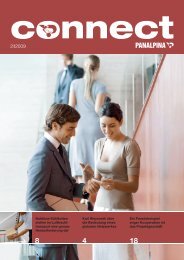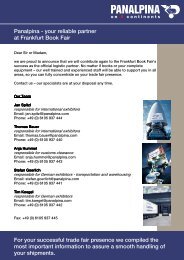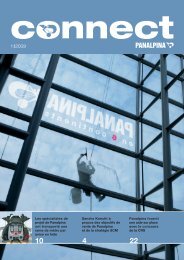Panalpina Annual Report 2006
Panalpina Annual Report 2006
Panalpina Annual Report 2006
You also want an ePaper? Increase the reach of your titles
YUMPU automatically turns print PDFs into web optimized ePapers that Google loves.
Consolidated and <strong>Annual</strong> Financial Statements <strong>2006</strong><br />
82 <strong>Panalpina</strong> <strong>Annual</strong> <strong>Report</strong> <strong>2006</strong><br />
Impairment of assets<br />
The Group assesses at each reporting date whether there is an indication that an asset may be impaired. If any such<br />
indication exists, or when annual impairment testing for an asset is required, the Group makes an estimate of the asset’s<br />
recoverable amount. An asset’s recoverable amount is the higher of an asset’s or cash-generating unit’s fair value less costs<br />
to sell and its value in use and is determined for an individual asset, unless the asset does not generate cash inflows<br />
that are largely independent of those from other assets or asset groups. Where the carrying amount of an asset exceeds its<br />
recoverable amount, the asset is considered impaired and is written down to its recoverable amount. In assessing value<br />
in use, the estimated future cash flows are discounted to their present value using a pre-tax discount rate that reflects current<br />
market assessments of the time value of money and the risks specific to the asset. In determining fair value less costs to<br />
sell, an appropriate valuation model is used. These calculations are corroborating by valuation multiples, quoted share<br />
prices for publicly traded subsidiaries or other available fair value indicators. Impairment losses are recognized in the income<br />
statement.<br />
For assets excluding goodwill, an assessment is made at each reporting date as to whether there is any indication that<br />
previously recognized impairment losses may no longer exist or may have decreased. If such indication exists, the Group<br />
makes an estimate of recoverable amount.<br />
The following criteria are also applied in assessing impairment of specific assets:<br />
Goodwill<br />
Goodwill is reviewed for impairment, annually or more frequently if events or changes in circumstances indicate that the<br />
carrying value may be impaired.<br />
Impairment is determined for goodwill by assessing the recoverable amount of the cash-generating unit, to which<br />
the goodwill relates. Where the recoverable amount to the cash-generating unit is less than the carrying amount of the<br />
cash-generating unit to which the goodwill has been allocated, an impairment loss is recognized. Impairment losses<br />
relating to goodwill cannot be reversed in future periods. The Group performs its annual impairment test of goodwill as of<br />
31 December.<br />
Intangible assets<br />
Intangible assets with indefinite useful lives are tested for impairment annually as of 31 December either individually or at<br />
the cash generating unit level, as appropriate.<br />
Financial assets<br />
The Group classifies its financial assets into the following categories: at fair value through profit and loss, loans and<br />
receivables and available-for-sale. The Group does not classify any financial instruments as held-to-maturity. The<br />
classification depends on the nature of the asset and the purpose of the transaction. The management determines the<br />
classification of its financial assets at initial recognition and re-evaluates this designation at every reporting date. The Group<br />
considers whether a contract contains an embedded derivative when the entity first becomes a party to it. The embedded<br />
derivatives are separated from the original contract which is not measured at fair value through profit or loss when the<br />
analysis shows that the economics characteristics and risks of embedded derivatives are not closely related to those of the<br />
host contract.<br />
All normal purchases and sales of financial assets are recognized on the trade date, which is the date that the Group<br />
commits to purchase the asset. Regular way purchases or sales are purchases or sales of financial assets that require<br />
delivery of assets within the period generally established by convention in the marketplace or regulation.<br />
Financial assets at fair value through profit or loss<br />
The category is subdivided in two categories: Financial assets held for trading and those designated at fair value through<br />
profit or loss at inception. A financial asset is classified if acquired principally for the purpose of generating a profit<br />
from short-term fluctuations in price. The Group’s investments in marketable securities are classified as held-for-trading.<br />
Such investments are included in current assets in the balance sheet. Marketable securities comprise only exchange-traded<br />
and readily realizable investments.<br />
Derivative financial instruments are generally categorized as held-for-trading unless they are designated and qualified as<br />
hedging instruments (the treatment of derivative financial instruments is outlined in the section Financial risk management).<br />
Receivables<br />
Receivables originated by the Group are financial assets that are created by providing money or services directly to<br />
the debtor. Such receivables are not quoted and not originated with the intent to be sold immediately or in the near-term.<br />
Receivables are presented in current assets for maturities up to twelve months; other receivables are presented in noncurrent<br />
assets.<br />
Loans and receivables are included in the following line items of the balance sheet: Trade receivables (treatment of the trade<br />
receivables is outlined in more details in section Trade receivables), other receivables and other current assets include:<br />
short-term active loans and other receivables and financial and other assets.



![Eigenes Luftfrachtnetzwerk [pdf | 244 KB] - Panalpina](https://img.yumpu.com/23347328/1/184x260/eigenes-luftfrachtnetzwerk-pdf-244-kb-panalpina.jpg?quality=85)
![Übersicht Panalpina [pdf | 240 KB]](https://img.yumpu.com/22547731/1/184x260/ubersicht-panalpina-pdf-240-kb.jpg?quality=85)

![Seefracht [pdf | 181 KB] - Panalpina](https://img.yumpu.com/22234724/1/184x260/seefracht-pdf-181-kb-panalpina.jpg?quality=85)
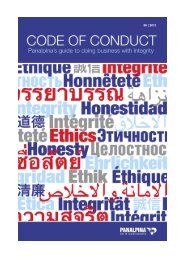
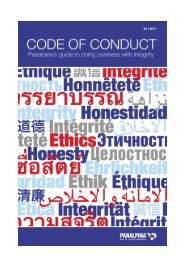

![Annual Report 2012 [pdf | 1 MB] - Panalpina](https://img.yumpu.com/15342099/1/184x260/annual-report-2012-pdf-1-mb-panalpina.jpg?quality=85)


